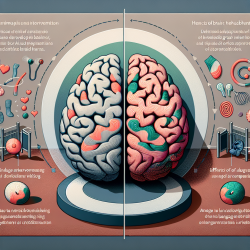Understanding the Impact of Early Deafness on Brain Plasticity
Early deafness presents a unique opportunity to study brain plasticity, the brain's remarkable ability to reorganize itself in response to sensory deprivation. Recent research, including a systematic review titled The Impact of Early Deafness on Brain Plasticity: A Systematic Review of the White and Gray Matter Changes, provides valuable insights into how early auditory deprivation affects brain structure and function. This knowledge is crucial for speech-language pathologists and educators working with deaf children, as it can inform more effective intervention strategies.
Key Findings from the Systematic Review
The review synthesizes data from 27 studies involving 626 deaf individuals, highlighting significant changes in both white and gray matter in the brains of those with early deafness. The most consistent alterations were observed in the bilateral superior temporal gyri, a region crucial for auditory processing and language comprehension. These changes underscore the importance of early intervention to mitigate the effects of auditory deprivation on neurocognitive development.
Moreover, the review reveals that early sign language acquisition can attenuate the negative impact of auditory deprivation. This finding suggests that incorporating sign language into early intervention programs could enhance language development and cognitive outcomes for deaf children.
Implications for Practitioners
For practitioners, these findings emphasize the importance of early and targeted interventions. Here are some actionable strategies:
- Early Diagnosis and Intervention: Identifying hearing loss as early as possible allows for timely intervention, which is critical during the sensitive period of brain development.
- Incorporate Sign Language: Encourage the use of sign language from an early age to support language development and cognitive growth.
- Multimodal Therapy Approaches: Utilize a combination of auditory, visual, and tactile stimuli to engage different sensory pathways and promote brain plasticity.
- Monitor and Adapt: Continuously assess the child's progress and adapt intervention strategies to meet their evolving needs.
Encouraging Further Research
While the current research provides a solid foundation, there is still much to learn about the intricacies of brain plasticity in deaf individuals. Practitioners are encouraged to stay informed about the latest findings and consider participating in or supporting research efforts. Collaboration between researchers and clinicians can lead to more nuanced understanding and innovative intervention strategies.
To read the original research paper, please follow this link: The Impact of Early Deafness on Brain Plasticity: A Systematic Review of the White and Gray Matter Changes.










